tow Citroen JUMPY 2016 2.G User Guide
[x] Cancel search | Manufacturer: CITROEN, Model Year: 2016, Model line: JUMPY, Model: Citroen JUMPY 2016 2.GPages: 595, PDF Size: 12.47 MB
Page 93 of 595

91
Jumpy _en_Chap02_ouvertures_ed01-2016
If the left-hand door is not fully closed
(the right-hand door is not detected):
-
v
ehicle stationary and engine
running, this warning lamp
comes on, accompanied by an
alert message for a few seconds,
-
v
ehicle moving (speed above
6 mph (10 km/h)), this warning
lamp comes on, accompanied
by an audible signal and an alert
message for a few seconds.
For more information on the Key,
Remote control or Keyless Entr y and
Starting and in particular unlocking
the vehicle, refer to the corresponding
section.
Side-hinged rear
doors
The side-hinged rear doors are asymmetrical.
The left-hand door is fitted with a lock.
F
A
fter unlocking the vehicle (using the
key, remote control or Keyless Entry and
Starting, depending on equipment) pull the
door handle. F
A
fter first opening the left-hand door, pull
the lever A towards you to open the right-
hand door.
From outside
Closing
F Close first the right-hand door, then the left-hand door.
If the left-hand door is closed
first, a buffer stop located on
the edge of the right-hand door
prevents it closing.
2
Access
Page 108 of 595

106
Jumpy _en_Chap03_ergonomie-et-confort_ed01-2016
Moduwork
Removing the flap
Removable flap
F Holding the flap with one hand, with your other hand turn the control at the top of the
flap to release it.
F
L
ower the flap to remove it from its
housing.
The cushion of the outer seat of the bench
seat can be raised up to the backrest to create
additional loading space in the cab.
A flap in the partition can be removed to allow
long objects to be carried.
Once the removable flap has been
removed, you can load long objects
under the outer seat. F
S
tow it behind the driver's seat, clipping it
to the fixing lugs.
F
T
urn the control at the top of the flap to
secure it.
Ease of use and comfort
Page 113 of 595
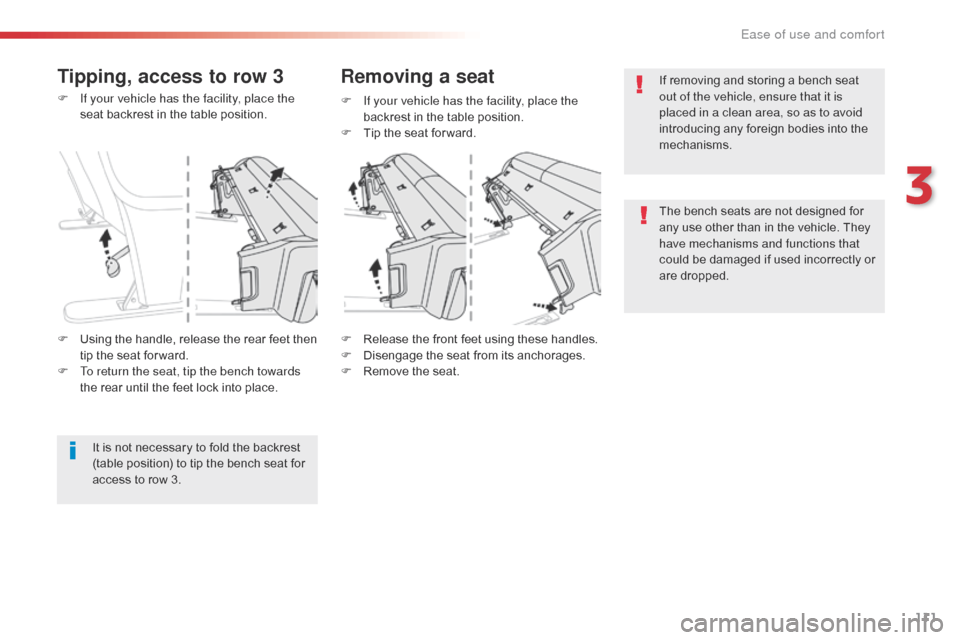
111
Jumpy _en_Chap03_ergonomie-et-confort_ed01-2016
F If your vehicle has the facility, place the seat backrest in the table position.
F
R
elease the front feet using these handles.
F
D
isengage the seat from its anchorages.
F
R
emove the seat.
F
I f your vehicle has the facility, place the
backrest in the table position.
F
T
ip the seat for ward.
Tipping, access to row 3 Removing a seat
It is not necessary to fold the backrest
(table position) to tip the bench seat for
access to row 3.
F
U
sing the handle, release the rear feet then
tip the seat for ward.
F
T
o return the seat, tip the bench towards
the rear until the feet lock into place. If removing and storing a bench seat
out of the vehicle, ensure that it is
placed in a clean area, so as to avoid
introducing any foreign bodies into the
mechanisms.
The bench seats are not designed for
any use other than in the vehicle. They
have mechanisms and functions that
could be damaged if used incorrectly or
are dropped.
3
Ease of use and comfort
Page 114 of 595

112
Jumpy _en_Chap03_ergonomie-et-confort_ed01-2016
F If your vehicle has the facility, pull the control and raise the backrest (from the
rear, lower the lever).
Check that the seat has correctly
engaged in its anchorages on the floor
when returned to the seating position. Ensure that no object, or the feet of a
passenger seated at the rear, could
obstruct the anchorage points or prevent
the correct latching of the assembly.
F
C
heck that there is nothing obstructing the
anchorages or which would prevent the
correct engagement of the feet.
Refitting a seat
F Lock the front feet using the handles.
F T ip the seat toward the rear until the rear
feet lock into place.
Be aware of the feet of any passengers
while tipping the seat.
F
E
ngage the front feet in the anchorages in
the floor (as shown above).
Ease of use and comfort
Page 117 of 595
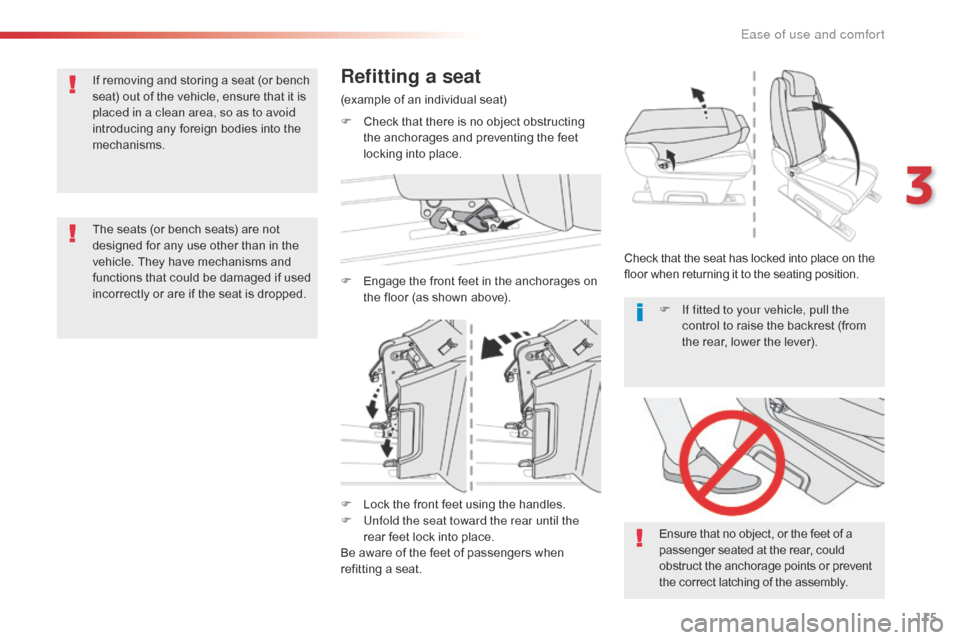
115
Jumpy _en_Chap03_ergonomie-et-confort_ed01-2016
F Lock the front feet using the handles.
F U nfold the seat toward the rear until the
rear feet lock into place.
Be aware of the feet of passengers when
refitting a seat. Ensure that no object, or the feet of a
passenger seated at the rear, could
obstruct the anchorage points or prevent
the correct latching of the assembly. F
I
f fitted to your vehicle, pull the
control to raise the backrest (from
the rear, lower the lever).
The seats (or bench seats) are not
designed for any use other than in the
vehicle. They have mechanisms and
functions that could be damaged if used
incorrectly or are if the seat is dropped. If removing and storing a seat (or bench
seat) out of the vehicle, ensure that it is
placed in a clean area, so as to avoid
introducing any foreign bodies into the
mechanisms.
Refitting a seat
(example of an individual seat)
F
C
heck that there is no object obstructing
the anchorages and preventing the feet
locking into place.
F
E
ngage the front feet in the anchorages on
the floor (as shown above). Check that the seat has locked into place on the
floor when returning it to the seating position.
3
Ease of use and comfort
Page 120 of 595
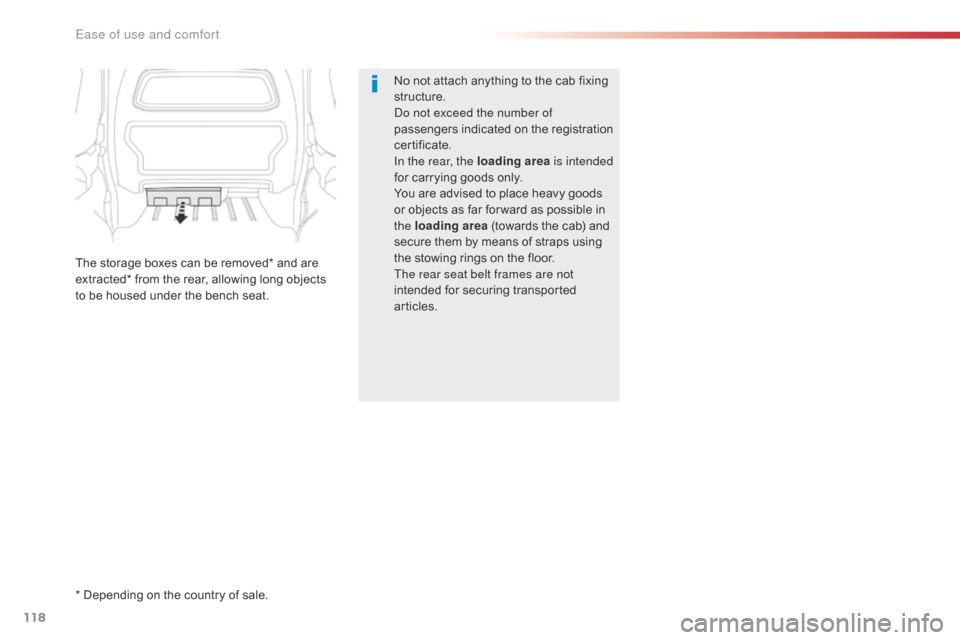
118
Jumpy _en_Chap03_ergonomie-et-confort_ed01-2016
No not attach anything to the cab fixing
structure.
Do not exceed the number of
passengers indicated on the registration
certificate.
In the rear, the loading area is intended
for carrying goods only.
You are advised to place heavy goods
or objects as far for ward as possible in
the loading area (towards the cab) and
secure them by means of straps using
the stowing rings on the floor.
The rear seat belt frames are not
intended for securing transported
articles.
The storage boxes can be removed* and are
extracted* from the rear, allowing long objects
to be housed under the bench seat.
* Depending on the country of sale.
Ease of use and comfort
Page 124 of 595
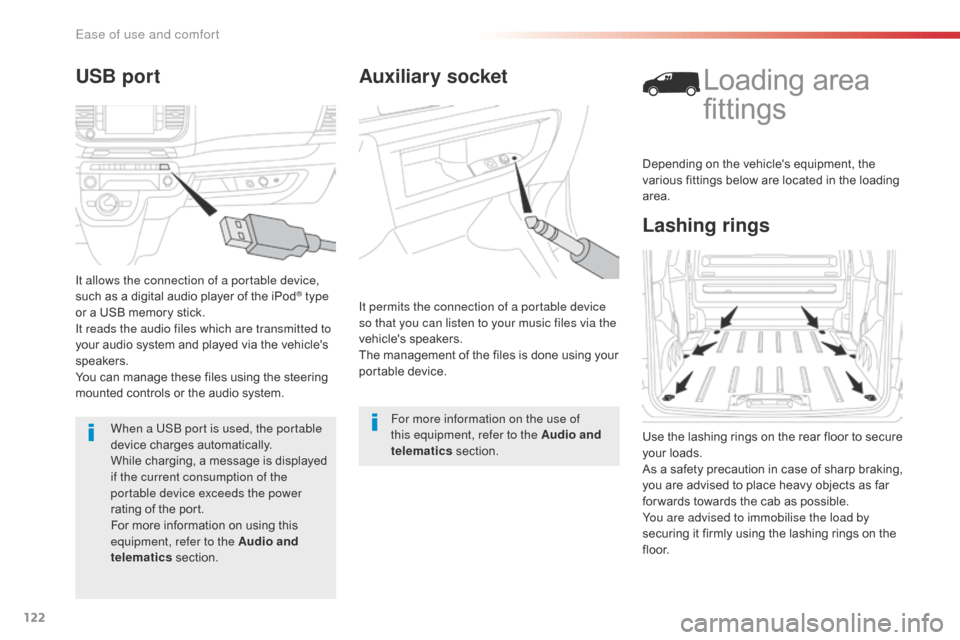
122
Jumpy _en_Chap03_ergonomie-et-confort_ed01-2016
Auxiliary socket
It permits the connection of a portable device
so that you can listen to your music files via the
vehicle's speakers.
The management of the files is done using your
portable device.For more information on the use of
this equipment, refer to the Audio and
telematics section.
Lashing rings
Loading area
fittings
Use the lashing rings on the rear floor to secure
your loads.
As a safety precaution in case of sharp braking,
you are advised to place heavy objects as far
for wards towards the cab as possible.
You are advised to immobilise the load by
securing it firmly using the lashing rings on the
f l o o r.Depending on the vehicle's equipment, the
various fittings below are located in the loading
area.
USB port
It allows the connection of a portable device,
such as a digital audio player of the iPod® type
or a USB memory stick.
It reads the audio files which are transmitted to
your audio system and played via the vehicle's
speakers.
You can manage these files using the steering
mounted controls or the audio system.
When a USB port is used, the portable
device charges automatically.
While charging, a message is displayed
if the current consumption of the
portable device exceeds the power
rating of the port.
For more information on using this
equipment, refer to the Audio and
telematics section.
Ease of use and comfort
Page 126 of 595
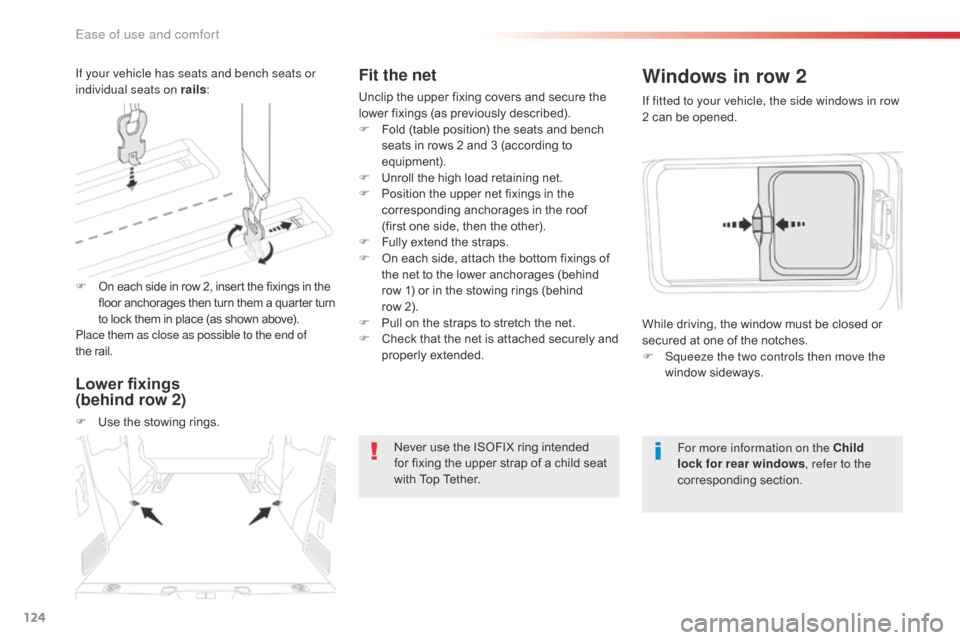
124
Jumpy _en_Chap03_ergonomie-et-confort_ed01-2016
Fit the net
Unclip the upper fixing covers and secure the
lower fixings (as previously described).
F
F
old (table position) the seats and bench
seats in rows 2 and 3 (according to
equipment).
F
U
nroll the high load retaining net.
F
P
osition the upper net fixings in the
corresponding anchorages in the roof
(first one side, then the other).
F
F
ully extend the straps.
F
O
n each side, attach the bottom fixings of
the net to the lower anchorages (behind
row 1) or in the stowing rings (behind
row
2).
F
P
ull on the straps to stretch the net.
F
C
heck that the net is attached securely and
properly extended.
Never use the ISOFIX ring intended
for fixing the upper strap of a child seat
with Top Tether. If fitted to your vehicle, the side windows in row
2 can be opened.
Windows in row 2
For more information on the Child
lock for rear windows
, refer to the
corresponding section.
While driving, the window must be closed or
secured at one of the notches.
F
S
queeze the two controls then move the
window sideways.
F
O
n each side in row 2, insert the fixings in the
floor anchorages then turn them a quar ter turn
to lock them in place (as shown above).
Place them as close as possible to the end of
the
rail.
If your vehicle has seats and bench seats or
individual seats on rails
:
Lower fixings
(behind row 2)
F Use the stowing rings.
Ease of use and comfort
Page 134 of 595

132
Jumpy _en_Chap03_ergonomie-et-confort_ed01-2016
Front demist - defrost
These markings on the control panel indicate the control positions for rapid demisting or
defrosting of the windscreen and side windows.
Manual heating/ventilation
or air conditioning
With Stop & Start, when demisting has
been activated, the STOP mode is not
available.
Dual-zone digital air
conditioning
F Put the air flow, temperature and distribution controls to the dedicated
marked position. The system automatically manages the air
conditioning, air flow and air intake, and
provides optimum distribution towards the
windscreen and side windows.
The system reverts to the previous settings. F
P
ress this button to demist or
defrost the windscreen and side
windows as quickly as possible.
F
T
o stop, press this button again
or on "AUTO".
F
F
or air conditioning, press
this button; its indicator lamp
comes
on. Heated windscreen and washer jets
For more information on the Wiper
control stalk
and in particular the
heated windscreen and washer jets,
refer to the corresponding section.
Ease of use and comfort
Page 137 of 595
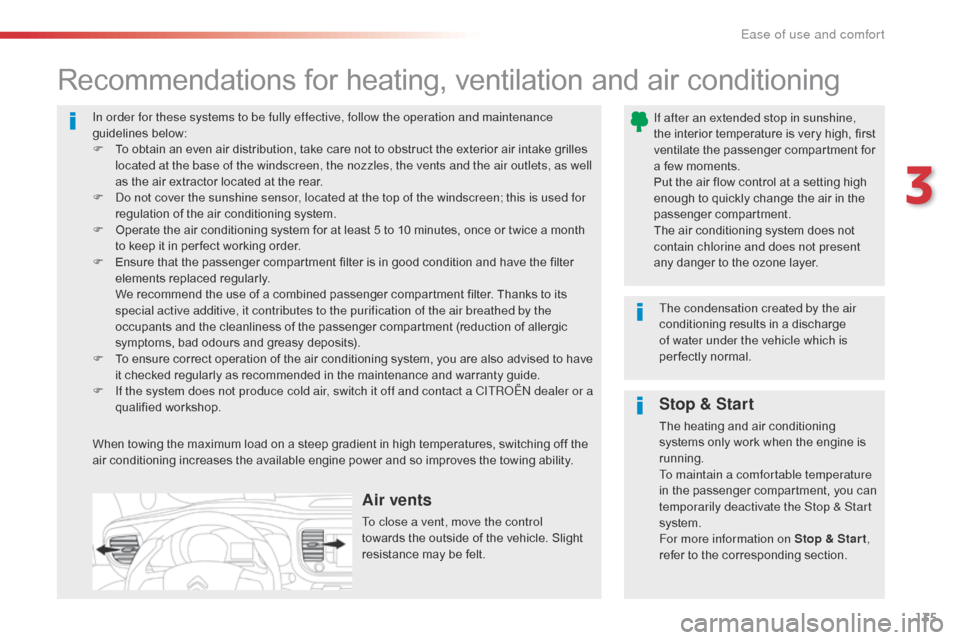
135
Jumpy _en_Chap03_ergonomie-et-confort_ed01-2016
In order for these systems to be fully effective, follow the operation and maintenance
guidelines below:
F
T
o obtain an even air distribution, take care not to obstruct the exterior air intake grilles
located at the base of the windscreen, the nozzles, the vents and the air outlets, as well
as the air extractor located at the rear.
F
D
o not cover the sunshine sensor, located at the top of the windscreen; this is used for
regulation of the air conditioning system.
F
O
perate the air conditioning system for at least 5 to 10 minutes, once or twice a month
to keep it in per fect working order.
F
E
nsure that the passenger compartment filter is in good condition and have the filter
elements replaced regularly.
W
e recommend the use of a combined passenger compartment filter. Thanks to its
special active additive, it contributes to the purification of the air breathed by the
occupants and the cleanliness of the passenger compartment (reduction of allergic
symptoms, bad odours and greasy deposits).
F
T
o ensure correct operation of the air conditioning system, you are also advised to have
it checked regularly as recommended in the maintenance and warranty guide.
F
I
f the system does not produce cold air, switch it off and contact a CITROËN dealer or a
qualified workshop.
Recommendations for heating, ventilation and air conditioning
If after an extended stop in sunshine,
the interior temperature is very high, first
ventilate the passenger compartment for
a few moments.
Put the air flow control at a setting high
enough to quickly change the air in the
passenger compartment.
The air conditioning system does not
contain chlorine and does not present
any danger to the ozone layer.
The condensation created by the air
conditioning results in a discharge
of water under the vehicle which is
per fectly normal.
When towing the maximum load on a steep gradient in high temperatures, switching off the
air conditioning increases the available engine power and so improves the towing ability.
Stop & Start
The heating and air conditioning
systems only work when the engine is
running.
To maintain a comfortable temperature
in the passenger compartment, you can
temporarily deactivate the Stop & Start
system.
For more information on Stop & Star t ,
refer to the corresponding section.
Air vents
To close a vent, move the control
towards the outside of the vehicle. Slight
resistance may be felt.
3
Ease of use and comfort